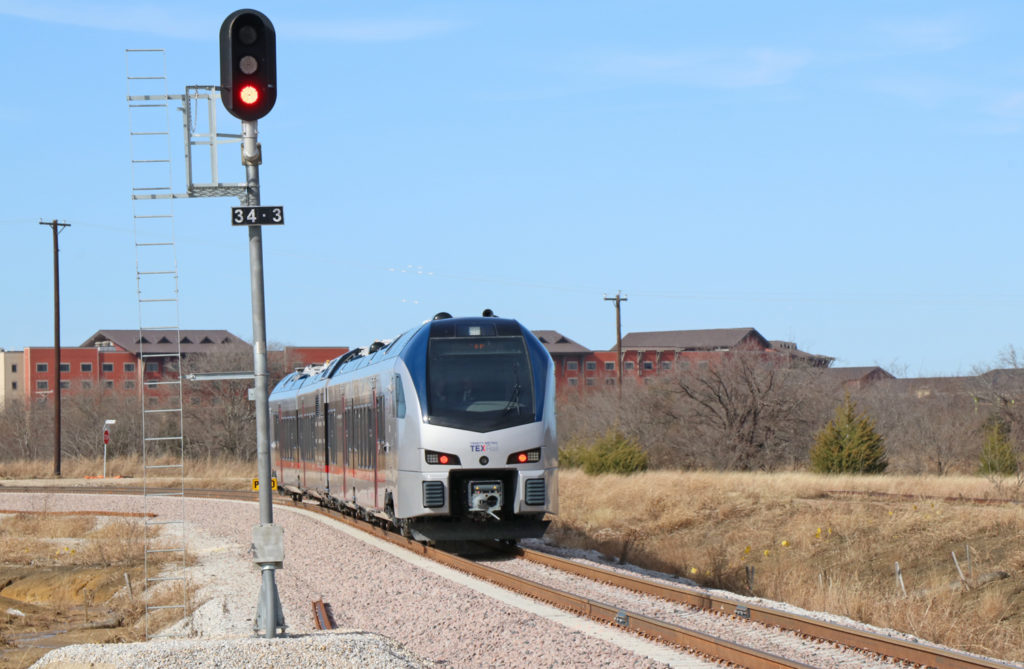All about the community of model railroading and rail enthusiasm
January 10, 2019 / Updated February 14, 2019

Despite a delayed launch, the first Trinity Metro TEXRail commuter train arrived on time at D/FW International Airport in the wee hours this morning with a handful of riders. The train’s arrival at Terminal B well before dawn marked the end of an 11-year journey to link downtown Fort Worth to the airport.
The first train to run fully across the 27-mile line departed Fort Worth T&P Station at 3:25 a.m. and arrived at the airport at 4:17. The train originated at Fort Worth North Side Station and reached the former Texas & Pacific Station, the western terminus, at 3:14 a.m.
“I think it’s going to be great for the community, great for the airport, great for Fort Worth,” Steve Crum, the train’s first rider, told CBS 11 News. “It’s a long time coming, well deserved.”
The $1 billion commuter line, which runs on the former
Cotton Belt railroad through Grapevine and to the airport, was derailed from
its planned Jan. 5 start because of a signal issue detected the day before. A
problem resulted from a hardware installation by Trinity Metro’s signal
contractor, the agency said, and further testing was needed.
By the end of the day the signal was fixed, but Trinity
Metro couldn’t get sign-off by the Federal Railroad Administration. TEXRail
officials did not blame the delay on the FRA being short-handed resulting from
the government shutdown.
“We greatly appreciate all of the efforts to move TEXRail from the testing phase to full service by all of the personnel at FRA,” Trinity Metro President and CEO Paul Ballard said.
TEXRail joins Trinity Railway Express and Dallas Area Rapid Transit as trains that either arrive at the airport or provide a nearby link. Each day TEXRail will send 21 trains hourly from 4:17 a.m. to 12:17 a.m. to Terminal B. Trains will leave the airport station from 4:55 a.m. to 12:55 a.m.
Nine stations in Fort Worth, North Richland Hills, Grapevine and the airport serve riders from downtown Fort Worth to the airport. Rides are free through the end of January. Starting Feb. 1, the cost for a one-way ticket on the 52-minute ride will be $2.50.
TEXRail made its official non-revenue debut New Year’s Eve when dignitaries rode trains from Fort Worth, North Richland Hills and Grapevine to a celebration near the airport. The event fulfilled officials’ promise that trains would not only run by the end of 2018 but prove to doubters that the line could become a reality.
From its start in 1997 when the corridor was identified, the project faced high funding hurdles and support. As early as five years ago TEXRail and its $26 million-per-mile cost drew criticism.
TEXRail broke ground in August 2016 before receiving the last piece of local and federal funding for the projected $1.0034 billion cost. Before year’s end, Trinity Metro and the Federal Transit Administration signed off on a $499.39 million Full Funding Grant Agreement to cinch the project.
Ballard, who was hired in 2013 to lead the project after successfully launching Nashville’s commuter line, was committed to get the project done on time and under budget, both of which were accomplished at the end of 2018.
“After all, this is a train that would never run,” he told about 500 over lunch at the D/FW North Airport Station at the celebration.
Scott Mahaffey, who presides over Trinity Metro’s board of directors, said TEXRail’s arrival comes at a time when Dallas/Fort Worth needs it most to manage the area’s population growth. The line, which is expected to draw 8,000 daily riders, will further the area’s growth and eventually connect with DART’s planned Cotton Belt commuter line from the airport to Plano.
“People really don’t realize what transit contributes,” Mahaffey said. “What it does is bring in activity and revenue. TEXRail has become the spine of the transit system. Activity is the most important thing we can bring to the table. We have more people moving in than moving out, and we have more people demanding different kinds of transit.”
By 2035 TEXRail is projected to draw 14,000 riders daily.
TEXRail’s fleet includes three Stadler FLIRT 3 (Fast Light Innovative Regional Train) diesel multiple unit (DMU) sets, the first to run in the U.S. The car exteriors were built in Hungary, and final production and assembly happened in Utah.
Each DMU has 229 seats and capacity of 488. Amenities include a designated quiet car, level boarding, bike racks, USB charging stations, seatback trays and overhead luggage storage.
TEXRail will operate seven days a week.
Ballard will oversee operations through the first quarter of this year before retiring April 15. Robert Baulsir, currently Trinity Metro’s senior vice president, will succeed Ballard.